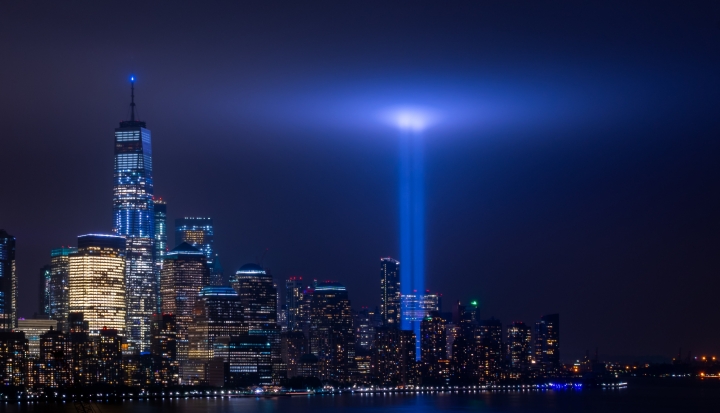Maryann Cusimano Love knew that it was only a matter of time before terrorists would hit the United States, but it was a dead car battery that kept her out of harm’s way on September 11. An expert in international relations who had advised both the Clinton and Bush administrations, Love was supposed to be teaching a class on terrorism in the wing of the Pentagon that was hit. All of her students survived, and one briefed the president that night.
“It was so frustrating to be right and to be just questioning, ‘What could I have done differently?’ ” Love says. Her pre-9/11 warnings were left unheeded as the Bush administration focused on threats from other countries. Despite her frustration, her military students encouraged her to keep speaking out on terrorism. “That was the only class we missed. We were back even with the smell of smoke.”
Since 2001 Love has had three children, written four best-selling children’s books, and continued to teach about terrorism at the Catholic University of America and the Pentagon. She serves the U.S. Catholic bishops’ International Justice and Peace Committee and the steering committee for the Catholic Peacebuilding Network.
“There are times as experts when you don’t like to be right, and that was one of those days,” Love says of September 11. “But it was also one of those days when you roll up your sleeves and say: We can do better than this.”
How can Catholics best commemorate the anniversary of September 11 and make sense of the last 10 years?
The Bible verse that’s most telling to me is “The Lord has not given us a spirit of fear but of power and love and a sound mind” (2 Tim. 1:7), and I think we really need to approach the anniversary with that in mind.
We are followers of the Prince of Peace. Our God is not a God of fear. What does it mean to be followers of the Prince of Peace after 10 years of the War on Terror? Can we imagine a different future, one that is not perpetual warfare?
And if we believe that the killing of innocents on September 11 was wrong, then we need to be doing more to protect civilians and noncombatants around the world—not just in New York City and Washington but also in Iraq and Afghanistan. Are our actions making them—and not just us—safer? We’re all part of the same family.
Are our actions at least making us safer?
People think that, because we’ve spent a whole lot of money since September 11, we are safer. The dirty secret is that most spending on the War on Terror has had nothing to do with combating terrorism. A lot of defense contractors have gotten very rich off our fear and have not made us one iota safer, while a lot of the programs that actually could and do make us safer are struggling for financial and political support.
Sometimes the simple things are the most effective ways to make us safe. Updating our roads and bridges, improving air traffic safety, and protecting our food supply and public health systems protect us against an array of everyday threats and from terrorists exploiting our civilian infrastructure.
Instead we’re spending billions on a Cold War military architecture, like aircraft carriers and the latest fighter jets for the Air Force, when Al Qaeda doesn’t have an air force. There’s a real mismatch between our values and what we’re doing to combat terrorism, and also a mismatch between what we’re doing and what actually works.
What works in fighting terrorism then?
The good news is that terrorists have never defeated a democratic state. Terrorism doesn’t win. It is, by definition, a desperate attempt by a minority group that does not have mass public support. Al Qaeda isn’t organizing mass social movements in central squares in Egypt and Jordan because they don’t have that kind of support.
Al Qaeda is of great concern to the United States, but groups that deliberately target noncombatants have been around since at least the 1700s. When terrorist groups have been defeated, it’s been by slow, long-term pressure, using law enforcement and intelligence, and addressing the larger-scale grievances that give greater sympathy and support to the cause.
The good news is that there’s a lot that works to combat terrorism. The bad news is that a good deal of what we’re doing now—military force—is what doesn’t work.
Can we win the War on Terror?
Terrorism will never be zeroed out. It is like crime. You will never get rid of murder, but you shouldn’t stop trying.
It will never be zeroed out in part because the stronger U.S. military forces are, the less likely a potential enemy will take us on militarily. This is Strategy 101: Go for your opponent’s weakest point. Our military is very strong, so enemies will attack our weak, unprotected civilian infrastructure.
Our future is in some ways that of Israel or of European states who know that the opportunity for terrorist attacks is always with you and that you need to minimize the risk. You have to protect your largest targets, your critical infrastructure, and use old-fashioned law enforcement and intelligence techniques to prevent terrorist attacks before they occur.
It’s wrong to assume that because we have killed Osama bin Laden this whole nightmare is going to be over. But the upside of acknowledging that there is no risk-free future—that we face risk every day, much more so from dying in a car accident than in a terrorist attack—is that it can help us remember our reliance on God and our connections to each other.
How have we fought the current War on Terror from an ethical point of view?
In 2001 you could find reasons to argue that invading Afghanistan was a just war in terms of self-defense, last resort, and probability of success. Although we were not struck by the government of Afghanistan, it was aiding and abetting those who did. We had taken other measures to try to rein in Al Qaeda and arrest Osama bin Laden.
But the question is: Do any of those criteria still apply today? Certainly last resort doesn’t anymore. We have many other means now. The government in Afghanistan is not supporting Al Qaeda or the Taliban. The war has assumed a logic of its own that is outliving the original justifications.
Invading Iraq was presented as being a part of the War on Terror, but it had nothing to do with it. The CIA’s own testimony to Congress said there was no Al Qaeda presence in Iraq prior to the U.S. military invasion. In fact, it was the U.S. military invasion that created Al Qaeda in Iraq.
That’s one of the things I was talking about as the wrong thing to be doing: The war in Iraq created a greater source of support and a basis of operations for Al Qaeda. Let’s not do that, and instead let’s do what works.
Why do you think the pope’s condemnation of the war in Iraq wasn’t considered?
I think we have a faith formation issue within our church. Catholics understand very clearly the church’s position on abortion or premarital sex, but they don’t understand what it teaches on war and peace. We have to ask ourselves how good a job we are doing of educating our youth and our adults.
Why is what the popes and bishops had to say about the war news to people? Why aren’t they hearing it from the pulpits and discussing it in their parishes?
Sometimes it seems to be a matter of what pastors feel comfortable speaking on. It’s easier to speak out about protection of babies. Who doesn’t like babies? It’s harder to speak out on the protection of people who are different from us and live in other countries, to say that they have just as much fundamental dignity as we do and that not all methods of protecting ourselves are equal. Some don’t work, and some are not morally permissible.
Coming to this realization requires that our religious educators, including clergy, and all Catholics do more soul-searching about how our faith plays out in daily life.
What would you like Catholics to know about Catholic teachings on war and peace?
More than 25 years ago the U.S. bishops published their peace pastoral, The Challenge of Peace, in which they said peacebuilding is everyone’s responsibility—as a church, in our schools, as individuals. It’s not just something for governments to do.
The pastoral was narrowly focused on nuclear weapons in the Cold War, and the bishops were criticized: “This is too idealistic. We’ll never see a world where the countries willingly give up nuclear weapons, or where there won’t be a rivalry between the United States and the Soviet Union.”
Well, the bishops were prescient. Everything they said came true. Now the rest of the world has been catching up. The United Nations has created a new Peacebuilding Commission. The U.S. Department of Defense states that we need to do more to build peace at the individual and grassroots level. We don’t realize how much our own tradition has to offer to the current debate.
That nonviolent resistance can be very effective is something most Catholics don’t understand, but we’ve seen it in Egypt and Tunisia. Sometimes it takes an outside example to help us draw on our own tradition.
How does the Catholic Church define peace differently from others?
For the U.S. military, peace is the absence of the use of military force right now. So if nothing’s blowing up today, that’s peace in Iraq, right?
The Catholic Church says, not so much. You have to rebuild social relationships, restore people who have been traumatized by violence, reintegrate refugees and internally displaced persons back into their communities, and rebuild the human infrastructure.We think about peace in a sustainable and holistic way, as being about education and development.
When the U.S. military or other state organizations talk about building peace, they’re really talking about construction projects. How many roads and bridges can we put in?
The Catholic Church says building peace is not just about bricks and mortar. It’s about rebuilding the people and the human community. If you don’t do that work, then the bricks-and-mortar stuff you rebuild today is going to be blown up tomorrow.
The world is moving in that direction. The Catholic concept of just war theory has been institutionalized in the Geneva Conventions and the U.S. Military Code of Justice. It’s taught in all the military academies.
Now the Catholic Peacebuilding Network (affiliated with the Kroc Institute for International Peace Studies at the University of Notre Dame) is working to understand what it is to actually build peace and make it sustainable over the long term. There’s greater appreciation for that, and the church can play a real role in reminding people what real peace is.
How is “just peace” different from other definitions of peace?
There must be just cause and right intention. You can have many reasons for doing something, and it doesn’t mean that you can’t have any self-interested reasons for pursuing peace. Peace costs less. It allows you to resume your business relationships. It allows greater prosperity. You don’t have to be a saint, but the common good is your primary intention. That’s very different from a national-interest perspective.
The Catholic tradition really contributes in the criteria of participation. Catholic Relief Services and Caritas Internationalis developed a peacebuilding handbook after the genocide in Rwanda, and six out of their 10 principles are about participation.
That is very different from the type of peace being built by the United Nations or the Department of Defense. They very rarely, if ever, ask for any input from the local population.
If you look at the United Nations-sponsored peace negotiations held since 1992, 98 percent have been without any—zero—participation of women. That’s a pretty significant omission. And there are many other omissions, such as of civil society groups, religious groups, and youth groups.
Obviously to build peace you need to be bringing together the key stakeholders in society, the ones who are going to be able to make that peace stick. If you are not including them in the discussions, it shouldn’t be a surprise to you if you don’t succeed.
Participation is not an important value for Catholic peacebuilders just because it works, but because we truly believe in the fundamental dignity of all human life. If all people have this sacred human dignity, then all people should be part of that process.
What would a Catholic approach to the War on Terror look like?
To rebuild Afghan security forces, we are giving them high-tech equipment. Afghanistan never was a functioning centralized state. There have always been high levels of illiteracy and poverty. But our focus has been on buying them guns instead of teaching them how to read.
Ten years into Afghanistan we’re just starting basic, six-week literacy training programs for Afghan security forces. That’s a much more cost-effective means of improving the performance and efficiency of Afghan security forces and decreasing their susceptibility to corruption than a lot of these big budget items.
That’s where a Catholic approach, looking at what are you doing to help the individual, can add a lot. What are you doing to help at the community level and not just the state level?
Whose responsibility is it to do this? The military’s? The church’s?
It’s not any one person’s job. That’s frustrating, but it also means we can each bring our strengths to the table.
We need to see a huge increase in the number of civilians doing peacebuilding—non-governmental organizations and the Department of State.
The problem is that military spending is popular in Congress. As long as we put about a third of our budget into the military, then peacebuilding is going to be a military job. They’re the only group with the capacity to do it.
I very much respect the folks in our military. They have a can-do attitude, and their hearts are often in the right place. They see the need for these programs and want to make it happen, but they are the first to tell you that this work should be done by civilians.
In fact, when Congress wouldn’t, the Department of Defense initially gave $100 million a year to the Department of State to start peacebuilding programs. That’s not a good way to operate, so as citizens we have a responsibility to ask our congressional representatives and ourselves why defense spending is a sacred cow.
Do we need a Department of Peace?
There’s now a U.S. Institute of Peace, a very important research organization funded by the federal government that most people don’t know about. Is it a big federal government agency with the power and resources of the Department of State or the Department of Defense? No, but it is something that didn’t exist 25 years ago.
More so, though, every agency of the U.S. government needs to be a department of peace. The peacebuilding approach is not something separate, but it is what you do in education, agriculture, development, and defense.
Rather than fight a probably long and losing political battle to create a separate agency, why not try to reframe the work of existing agencies? Is USAID contributing to conflict by building a development project without the input of local communities? Are you thinking about the conflict ramifications when you build a road, or have you just created a more efficient way for the drug lords to get their goods to market?
Why should the U.S. be involved in peacebuilding overseas anyway?
People are generally opposed to imposed reconstruction under the guise of nationbuilding. We should be doing less of that because we should be doing more early on. Earlier interventions are cheaper and go a long way.
Peacebuilding works. In the past 20 years the number of major active armed conflicts in which more than a thousand people have died has gone from 33 to 16. When we do conflict prevention, education, economic development—things that keep a country from falling apart—then you don’t face the high-cost emergency room triage.
And there are connections between conflict and wealth. The more prosperous people around the world are the more they’re able to buy our products and the less pressure there is on the border for illegal immigration because people will be willing to stay in their countries of origin. It is in the self-interest of Americans to build peace around the world, and it’s also the morally appropriate thing to do.
As a mother, how do you think your children’s world is different from that of previous generations, growing up in a post-September 11 world?
I was looking at old photos recently with my kids, ages 2, 4, and 7. They were surprised to see us sledding on Capitol Hill, which we were allowed to do.
We recently had to fly with our 2-year-old, and she could not understand why she had to take off her shoes. She loves her shoes. Everything else was OK, but she screamed about her shoes.
There are things that are part of their existence that are not going to go away. We’re not going to stop having the security restrictions. We didn’t use to have to concern ourselves with explaining why they’re there and how we all need to do our part to make a safer world, but now kids are exposed to that at a very young age.
What effect does that have on them?
I think it’s a question of balance. It puts a strong onus on us to be sharing a positive message of hope and peace with our children.
They’re going to get the message of fear and war from the security processes, the media, our political culture. Some studies show that boys have a fully developed concept of war by age 4. We have never had toy guns in our home, but my son understands what guns are. We don’t watch violent videos, but it’s in the culture. Boys pick up sticks and pretend they’re guns and shoot people.
They will get those messages no matter how much we try to protect them from their intensity. So it’s our responsibility to be giving them other visions and messages: that peace is possible, about people who are working toward peace, or how peace is succeeding and wars are ending.
There’s a lot of good news out there that they won’t get from the media and our culture. They have to get those things from us, or they’re going to have a very distorted view of the world as they grow up.
This article appeared in the September 2011 issue of U.S. Catholic (Vol. 76, No. 9, pages 12-16).
Image: Jesse Mills on Unsplash












Add comment